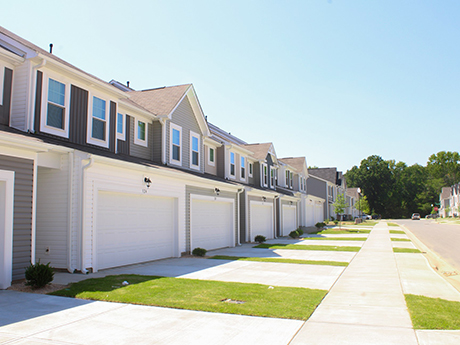Charlotte’s multifamily market is turning a corner after a once-in-a-generation supply wave that introduced 19,000 new apartments into the metro area in 2024. While rent growth will be muted for most of the year as the market continues to absorb the new supply, the dynamic will shift toward the end of 2025, putting landlords back in the driver’s seat.

Record-low new apartment starts this year, combined with steady population growth and an economic climate that favors renting over owning will boost leasing activity in the second half of the year — and may even produce rent growth for the first time since 2022.
Fundamentals in play
Like many other Sun Belt cities, Charlotte has been on a joyride of growth stemming from in-migration since the COVID-19 pandemic. The city’s population expanded 2.2 percent between 2023 and 2024, making it one of the fastest-growing markets in the Southeast. Another 56,000 new residents are expected to move in by the end of the year, according to research from Berkadia.
The long-term forecast for population growth is even rosier: the Charlotte Regional Business Alliance forecasts the metro population will surge by 50 percent over the next 25 years, driving demand for housing.
Tariff anxiety notwithstanding, Charlotte’s economy has also been on a roll. Employment is forecast to grow 1.2 percent this year, pushing the total workforce to 1.4 million, and median household income is forecast to grow 3.1 percent to $80,848, according to Berkadia. Charlotte’s strongest industries include healthcare, manufacturing, technology and energy. Large projects include Atrium Health’s $892 million hospital tower expansion in Uptown and Siemens Energy’s new $150 million plant, which will create 500 jobs upon completion.
Steady population and job growth, combined with the tapering of new apartment supply, will place operators in a better position by the end of 2025. Leasing activity is expected to accelerate, with absorption (21,585 units) exceeding deliveries (20,131 units) for the first time since 2021, according to Berkadia. Effective rent is expected to rise 2 percent to $1,558 per month by the end of the year, as occupancy increases 110 basis points to 93.9 percent. These gains mark a turning point following three years of flat-to-declining rent growth due to oversupply.
As of first-quarter 2025, Charlotte’s effective rent was down 0.6 percent year-over-year to $1,540, with 18,525 units absorbed during the trailing four quarters, pushing occupancy up slightly to 93.7 percent.
BTR hotspot
Apartment development in Charlotte shifted into high gear in 2020 with the delivery of over 11,000 units, and last year saw deliveries peak at just over 19,000 units, according to CoStar Group. Developers sought to meet a wave of renter demand for Class A urban and suburban garden-style apartment communities.
But some of the biggest growth has been in detached single-family homes or townhome rentals in build-to-rent (BTR) communities. At the start of this year, there were 36 different BTR communities under construction in the Charlotte metro area, and another 29 in the lease-up stage, totaling more than 7,000 units. With so many new units under development, Charlotte ranks second only to Phoenix for its BTR pipeline. About half of these new communities are located outside the I-485 Beltway.
With many residents locked out of homebuying due to high interest rates, BTR offers a middle ground between single-family living and traditional apartment renting — an increasingly appealing tradeoff for renters by choice.
Investment dynamics
Charlotte’s 2024 transaction volume totaled over $1.65 billion across 42 deals, with an average price of $215,556 per unit and $211 per square foot. This was well below the peak volume of 2021 and 2022 ($5.8 billion) but more in line with pre-pandemic norms, which hovered around $3 billion annually. Top-tier trades exceeded $300,000 per unit, including the Museum Tower at $389,000 per unit and The Crown of Queen City at $340,000 per unit.
New-to-market buyers were the most eager to transact in 2024. Of the 42 deals that traded in the Charlotte metro last year, 18 (or 43 percent) were by new-to-market companies. Six investment firms, including Tablerock Capital, Brookfield and Ares Management, acquired more than one asset. Meanwhile, many of the region’s largest institutional owners, like Blackstone and Camden Property Trust, opted not to expand their Charlotte apartment portfolios last year.
Capital markets volatility continues to be the predominant headwind this year, and it’s likely we’ll see owners recapitalizing construction loans this year.
Fewer starts, smarter growth
Charlotte’s multifamily outlook is defined by three intersecting trends: a high watermark for deliveries, a robust BTR segment and shrinking new supply heading into 2026.
With rent growth returning and absorption regaining its footing, many investors see 2025 as a transitional year, one that will reward value-add and core-plus strategies over riskier development plays, particularly if tariffs have the effect of driving up materials costs. Markets outside the urban core, particularly those with proximity to transit corridors or employment hubs, are expected to outperform.
In a market where long-term fundamentals remain strong, Charlotte is poised to reward those with patience, precision and a willingness to look beyond the Beltway.
— By Caleb Troop, senior managing director, Berkadia. This article was originally published in the June 2025 issue of Southeast Real Estate Business.


